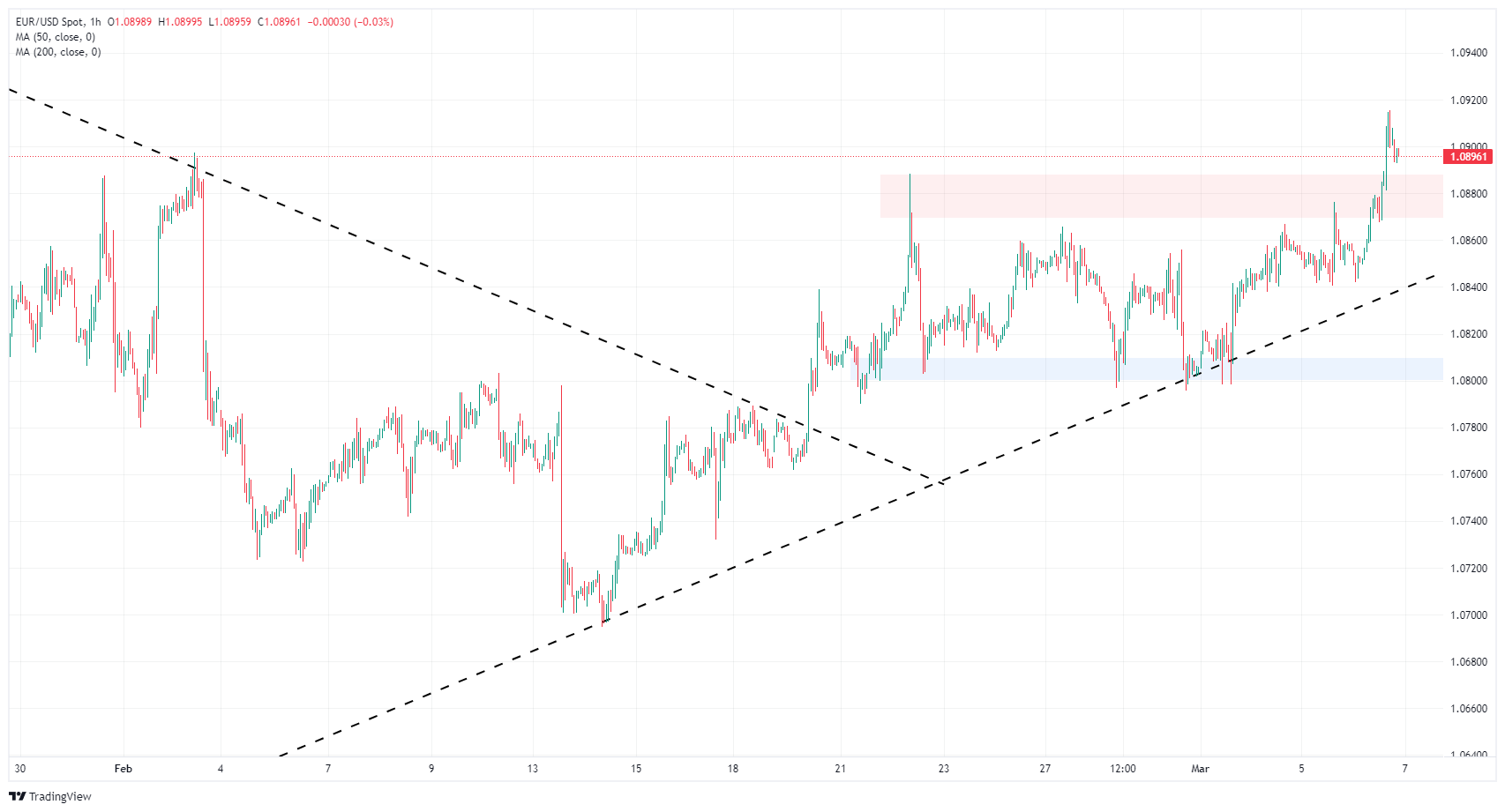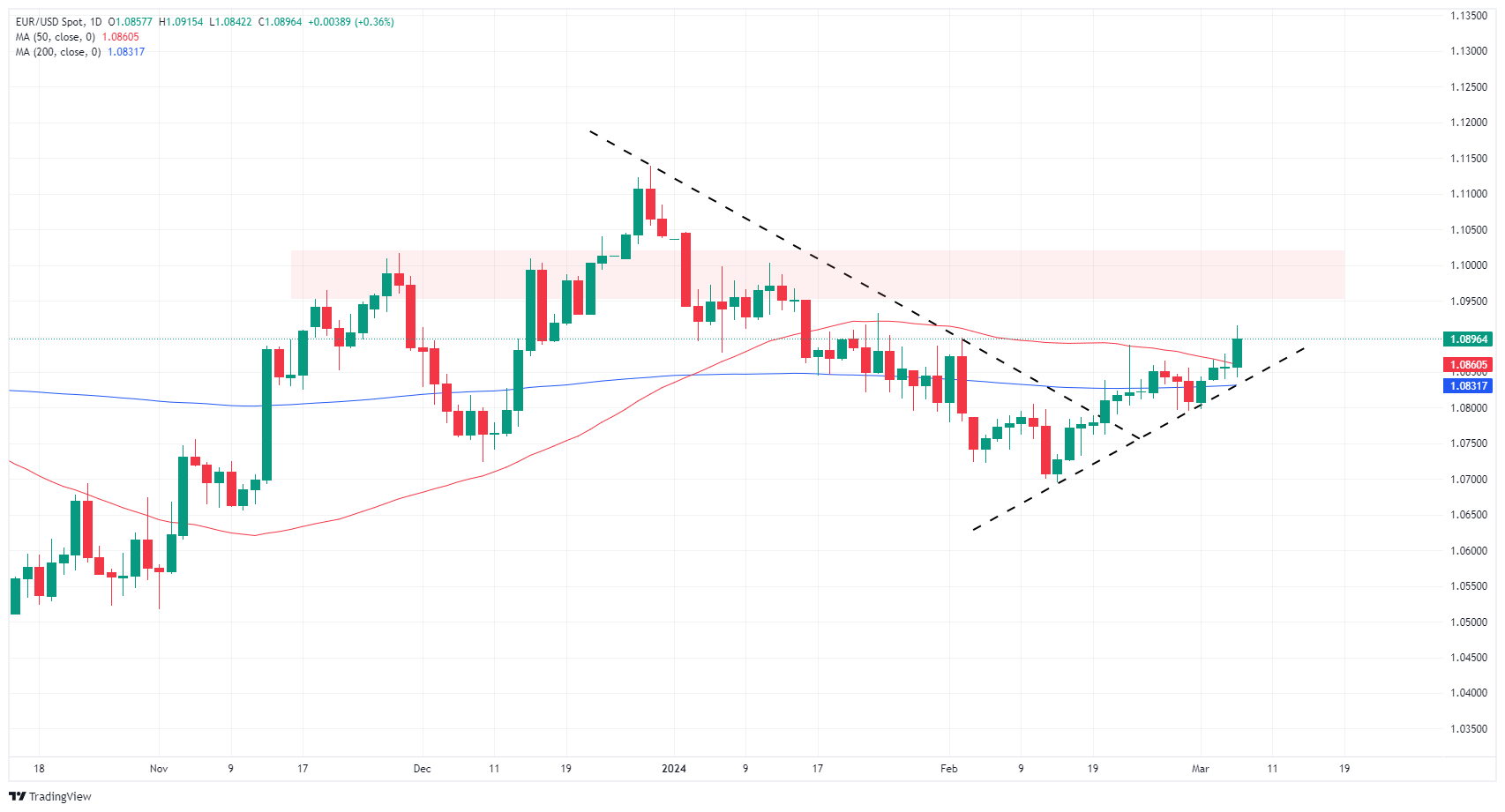- Analytics
- News and Tools
- Market News
- EUR/USD tests five-week high after Fed Powell affirms policy loosening likely this year
EUR/USD tests five-week high after Fed Powell affirms policy loosening likely this year
- Fed Chair Powell doesn’t foresee high risk of recession this year.
- European Retail Sales figures beat expectations.
- US labor numbers eased ahead of Friday’s NFP.
EUR/USD tested into its highest bids since late January, briefly crossing 1.0900 to tap 1.0915 before settling back slightly but still well into the green for Wednesday. The pair is on pace to close in the green for a fourth consecutive trading day as markets gear up for another outing from Federal Reserve (Fed) Chairman Jerome Powell on Thursday and Friday’s Nonfarm Payrolls (NFP) labor report.
Fed Chair Powell will be speaking again on Thursday for the second half of two-day testimony before the US Congressional House Financial Services Committee. Friday’s US NFP jobs additions figure is expected to ease to 200K in February, down from January’s 11-month peak of 353K. Before Friday’s NFP, markets will be looking out for the European Central Bank’s (ECB) latest rate call, due at 13:15 GMT on Thursday.
Daily digest market movers: EUR/USD finds room up top after Fed talks down Greenback
- Pan-European Retail Sales fell less than expected for the year ended January, printing at -1.0% compared to the forecast -1.3%, but still down from the previous print of -0.5% (revised up slightly from -0.8%).
- US ADP Employment Change for February came in at 140K, below the forecast 150K but still higher than the previous month’s 111K, which was also revised higher from 107K.
- Fed Chair Powell:
- There is no reason to think the economy is in or faces significant near-term risk of recession.
- Fed sees ongoing solid growth, should continue moving forward.
- Would like to have more confidence on inflation. Fed has some confidence but needs more.
- Jerome Powell Speech: Fed Chair doesn't see elevated risk of recession
Euro price today
The table below shows the percentage change of Euro (EUR) against listed major currencies today. Euro was the strongest against the US Dollar.
| USD | EUR | GBP | CAD | AUD | JPY | NZD | CHF | |
| USD | -0.37% | -0.22% | -0.57% | -0.91% | -0.41% | -0.67% | -0.19% | |
| EUR | 0.37% | 0.15% | -0.19% | -0.53% | -0.04% | -0.28% | 0.19% | |
| GBP | 0.22% | -0.15% | -0.34% | -0.67% | -0.18% | -0.44% | 0.04% | |
| CAD | 0.56% | 0.21% | 0.33% | -0.32% | 0.15% | -0.10% | 0.37% | |
| AUD | 0.90% | 0.54% | 0.68% | 0.33% | 0.49% | 0.23% | 0.72% | |
| JPY | 0.41% | 0.03% | 0.17% | -0.15% | -0.49% | -0.26% | 0.20% | |
| NZD | 0.65% | 0.30% | 0.42% | 0.10% | -0.24% | 0.25% | 0.49% | |
| CHF | 0.19% | -0.19% | -0.04% | -0.38% | -0.71% | -0.23% | -0.48% |
The heat map shows percentage changes of major currencies against each other. The base currency is picked from the left column, while the quote currency is picked from the top row. For example, if you pick the Euro from the left column and move along the horizontal line to the Japanese Yen, the percentage change displayed in the box will represent EUR (base)/JPY (quote).
Technical analysis: EUR/USD attempts to push off of recent 1.0850 congestion
EUR/USD saw a five-week high at 1.0915 on Wednesday, climbing roughly two-thirds of a percent over the day to end the day just below 1.0900. Intraday price action broke through a near-term resistance zone to pierce the 1.0900 handle.
The pair is set to close in the green for a fourth straight trading day, and EUR/USD has risen nearly 2% from the last swing low into the 1.0700 handle.
EUR/USD hourly chart
EUR/USD daily chart
Euro FAQs
The Euro is the currency for the 20 European Union countries that belong to the Eurozone. It is the second most heavily traded currency in the world behind the US Dollar. In 2022, it accounted for 31% of all foreign exchange transactions, with an average daily turnover of over $2.2 trillion a day. EUR/USD is the most heavily traded currency pair in the world, accounting for an estimated 30% off all transactions, followed by EUR/JPY (4%), EUR/GBP (3%) and EUR/AUD (2%).
The European Central Bank (ECB) in Frankfurt, Germany, is the reserve bank for the Eurozone. The ECB sets interest rates and manages monetary policy. The ECB’s primary mandate is to maintain price stability, which means either controlling inflation or stimulating growth. Its primary tool is the raising or lowering of interest rates. Relatively high interest rates – or the expectation of higher rates – will usually benefit the Euro and vice versa. The ECB Governing Council makes monetary policy decisions at meetings held eight times a year. Decisions are made by heads of the Eurozone national banks and six permanent members, including the President of the ECB, Christine Lagarde.
Eurozone inflation data, measured by the Harmonized Index of Consumer Prices (HICP), is an important econometric for the Euro. If inflation rises more than expected, especially if above the ECB’s 2% target, it obliges the ECB to raise interest rates to bring it back under control. Relatively high interest rates compared to its counterparts will usually benefit the Euro, as it makes the region more attractive as a place for global investors to park their money.
Data releases gauge the health of the economy and can impact on the Euro. Indicators such as GDP, Manufacturing and Services PMIs, employment, and consumer sentiment surveys can all influence the direction of the single currency. A strong economy is good for the Euro. Not only does it attract more foreign investment but it may encourage the ECB to put up interest rates, which will directly strengthen the Euro. Otherwise, if economic data is weak, the Euro is likely to fall. Economic data for the four largest economies in the euro area (Germany, France, Italy and Spain) are especially significant, as they account for 75% of the Eurozone’s economy.
Another significant data release for the Euro is the Trade Balance. This indicator measures the difference between what a country earns from its exports and what it spends on imports over a given period. If a country produces highly sought after exports then its currency will gain in value purely from the extra demand created from foreign buyers seeking to purchase these goods. Therefore, a positive net Trade Balance strengthens a currency and vice versa for a negative balance.
© 2000-2024. All rights reserved.
This site is managed by Teletrade D.J. LLC 2351 LLC 2022 (Euro House, Richmond Hill Road, Kingstown, VC0100, St. Vincent and the Grenadines).
The information on this website is for informational purposes only and does not constitute any investment advice.
The company does not serve or provide services to customers who are residents of the US, Canada, Iran, The Democratic People's Republic of Korea, Yemen and FATF blacklisted countries.
Making transactions on financial markets with marginal financial instruments opens up wide possibilities and allows investors who are willing to take risks to earn high profits, carrying a potentially high risk of losses at the same time. Therefore you should responsibly approach the issue of choosing the appropriate investment strategy, taking the available resources into account, before starting trading.
Use of the information: full or partial use of materials from this website must always be referenced to TeleTrade as the source of information. Use of the materials on the Internet must be accompanied by a hyperlink to teletrade.org. Automatic import of materials and information from this website is prohibited.
Please contact our PR department if you have any questions or need assistance at pr@teletrade.global.















